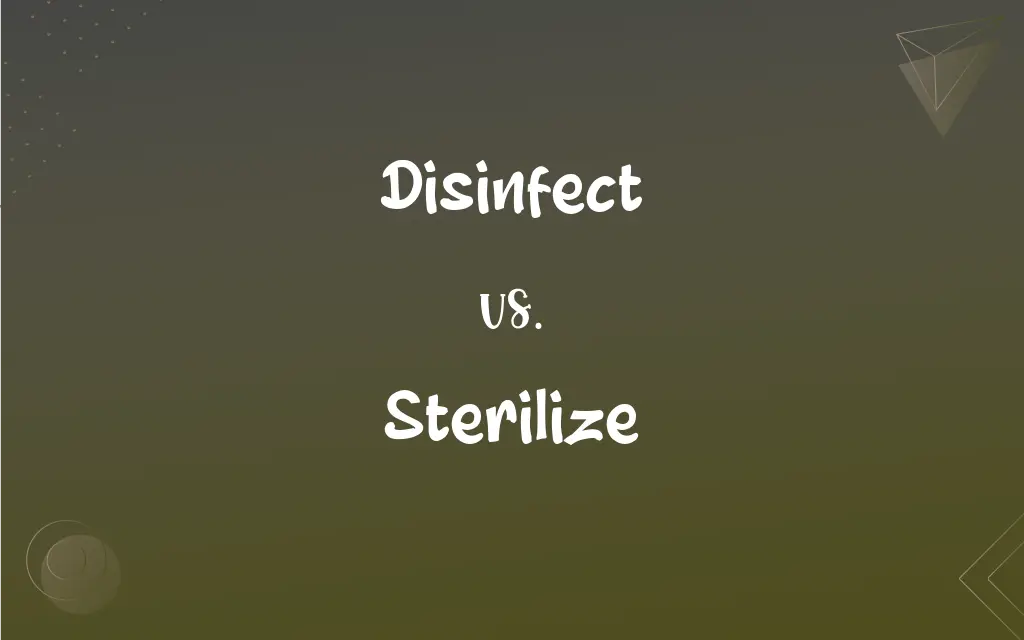Disinfect vs. Sterilize: What's the Difference?
Edited by Aimie Carlson || By Janet White || Published on October 1, 2024
Disinfecting reduces pathogens to safe levels on surfaces, while sterilizing eliminates all forms of microbial life, including spores.

Key Differences
Disinfecting involves using chemicals to reduce the number of harmful microorganisms on surfaces to a level considered safe by public health standards. It does not necessarily kill all microbes but targets bacteria, viruses, and fungi that can cause disease. Sterilizing, in contrast, is a process that destroys or eliminates all forms of microbial life, including bacteria, viruses, fungi, and spores, usually through heat, chemicals, or radiation. This process is critical in medical and laboratory settings, where sterile conditions are required to prevent contamination and infection, especially during surgeries or in the handling of sterile medical equipment.
Disinfecting can be sufficient for everyday cleaning and reducing the risk of spreading infections, sterilizing is necessary for situations where absolute cleanliness is required. For instance, disinfecting a kitchen counter can help prevent foodborne illnesses by reducing the presence of harmful bacteria, but sterilizing surgical instruments is essential to prevent post-operative infections.
The choice between disinfecting and sterilizing depends on the context and the level of microbial cleanliness required. Disinfectants are widely available and used for routine cleaning of surfaces that people frequently touch, such as door handles, countertops, and bathroom fixtures. On the other hand, sterilization processes are more complex and typically reserved for specific tools and environments in healthcare and laboratory settings.
Both disinfecting and sterilizing are crucial for controlling the spread of microbes, they serve different purposes. Disinfecting is about reducing harmful microorganisms to safe levels, whereas sterilizing is about achieving a completely microbe-free environment. The effectiveness of disinfection can vary based on the type of disinfectant and the nature of the surface, while sterilization requires strict protocols to ensure the total elimination of microbial life.
Comparison Chart
Goal
Reduce pathogens to safe levels
Eliminate all forms of microbial life
ADVERTISEMENT
Methods
Chemicals, UV light
Heat, chemicals, radiation
Common Use
Households, public spaces
Medical equipment, surgical areas
Effectiveness
Does not kill all microbes
Kills all microbes, including spores
Required in
Everyday cleaning
Procedures requiring sterility
Disinfect and Sterilize Definitions
Disinfect
The process of making something free of infection-causing organisms.
The clinic staff disinfect exam rooms between each patient visit.
ADVERTISEMENT
Sterilize
The process of destroying all microbial life, including spores.
In microbiology labs, technicians sterilize culture media to prevent contamination.
Disinfect
Using chemical agents to cleanse surfaces of pathogens.
Following the cooking class, the team disinfected all the used utensils and surfaces.
Sterilize
The act of achieving total cleanliness by eliminating all germs.
Hospitals sterilize surgical areas to protect patients from infections.
Disinfect
Applying a disinfectant to surfaces for hygiene purposes.
To prevent the flu, he decided to disinfect his phone and laptop regularly.
Sterilize
Implementing practices to create a sterile condition.
Before invasive procedures, medical devices are sterilized to uphold patient safety.
Disinfect
The act of reducing the number of harmful microbes to a safe level.
After the flood, they had to disinfect all the water-damaged furniture.
Sterilize
To make an object free from all forms of living microorganisms.
Surgeons rely on autoclaves to sterilize instruments before surgery.
Disinfect
To clean an area or object with chemicals to destroy bacteria.
She used bleach to disinfect the kitchen countertops after cooking.
Sterilize
Using heat or chemicals to ensure objects are completely microbe-free.
After each use, the dental tools are sterilized to maintain a sterile environment.
Disinfect
To cleanse so as to destroy or prevent the growth of disease-carrying microorganisms
Disinfect a hospital room.
Sterilize
To make free from live bacteria or other microorganisms.
Disinfect
To sterilize by the use of cleaning agent.
Sterilize
To eliminate the ability of a person or animal to produce offspring, as by altering or removing the reproductive organs.
Disinfect
To free from infectious or contagious matter; to destroy putrefaction; to purify; to make innocuous.
When the infectious matter and the infectious matter and the odoriferous matter are one . . . then to deodorize is to disinfect.
Sterilize
To make incapable of bearing fruit or germinating.
Disinfect
Destroy microorganisms or pathogens by cleansing;
Disinfect a wound
FAQs
Can disinfecting kill viruses?
Yes, disinfecting can kill many viruses on surfaces.
What does it mean to disinfect?
To apply a chemical agent to reduce harmful microorganisms to safe levels.
What is sterilization?
A process that destroys all forms of microbial life, including spores.
Is sterilizing better than disinfecting?
Sterilizing is more thorough, eliminating all microbes, not just reducing them.
What chemicals are used to disinfect?
Bleach, alcohol, and hydrogen peroxide are common disinfectants.
What's the difference in use between disinfect and sterilize?
Disinfect for general cleaning, sterilize for medical tools and procedures requiring sterility.
Is UV light a disinfectant or sterilizer?
UV light can disinfect, but its effectiveness as a sterilizer depends on exposure time and intensity.
Can disinfecting prevent the spread of colds and flu?
Yes, by reducing the presence of viruses on surfaces.
Is alcohol a disinfectant or sterilant?
Alcohol is a disinfectant; it does not achieve sterilization because it doesn't kill all spores.
Can sterilization be reversed?
Once an item is sterilized, it remains sterile until exposed to contaminants.
What is the main goal of disinfecting in homes?
To reduce the risk of infection by lowering the number of harmful germs.
How do hospitals sterilize equipment?
Through autoclaving, using high-pressure steam, or chemical sterilants.
Can I disinfect my skin?
Disinfectants are for surfaces, not for skin; antiseptics are used on skin.
How often should I disinfect my home?
Regularly, especially high-touch areas, to reduce infection risk.
Can I sterilize something at home?
Some items can be sterilized with boiling water or chemical solutions, depending on the item.
Do disinfectants work instantly?
Most require a dwell time to effectively kill microbes.
What items should be sterilized?
Medical instruments, surgical tools, and anything entering sterile body areas.
Why is sterilization crucial in hospitals?
To prevent infections, especially in surgeries or when using invasive devices.
How do I know if a surface is disinfected?
If proper disinfectant and method are used, surfaces are considered disinfected after the recommended dwell time.
Are all microbes harmful?
No, but disinfecting and sterilizing target those that can cause disease.
About Author
Written by
Janet WhiteJanet White has been an esteemed writer and blogger for Difference Wiki. Holding a Master's degree in Science and Medical Journalism from the prestigious Boston University, she has consistently demonstrated her expertise and passion for her field. When she's not immersed in her work, Janet relishes her time exercising, delving into a good book, and cherishing moments with friends and family.
Edited by
Aimie CarlsonAimie Carlson, holding a master's degree in English literature, is a fervent English language enthusiast. She lends her writing talents to Difference Wiki, a prominent website that specializes in comparisons, offering readers insightful analyses that both captivate and inform.






































































